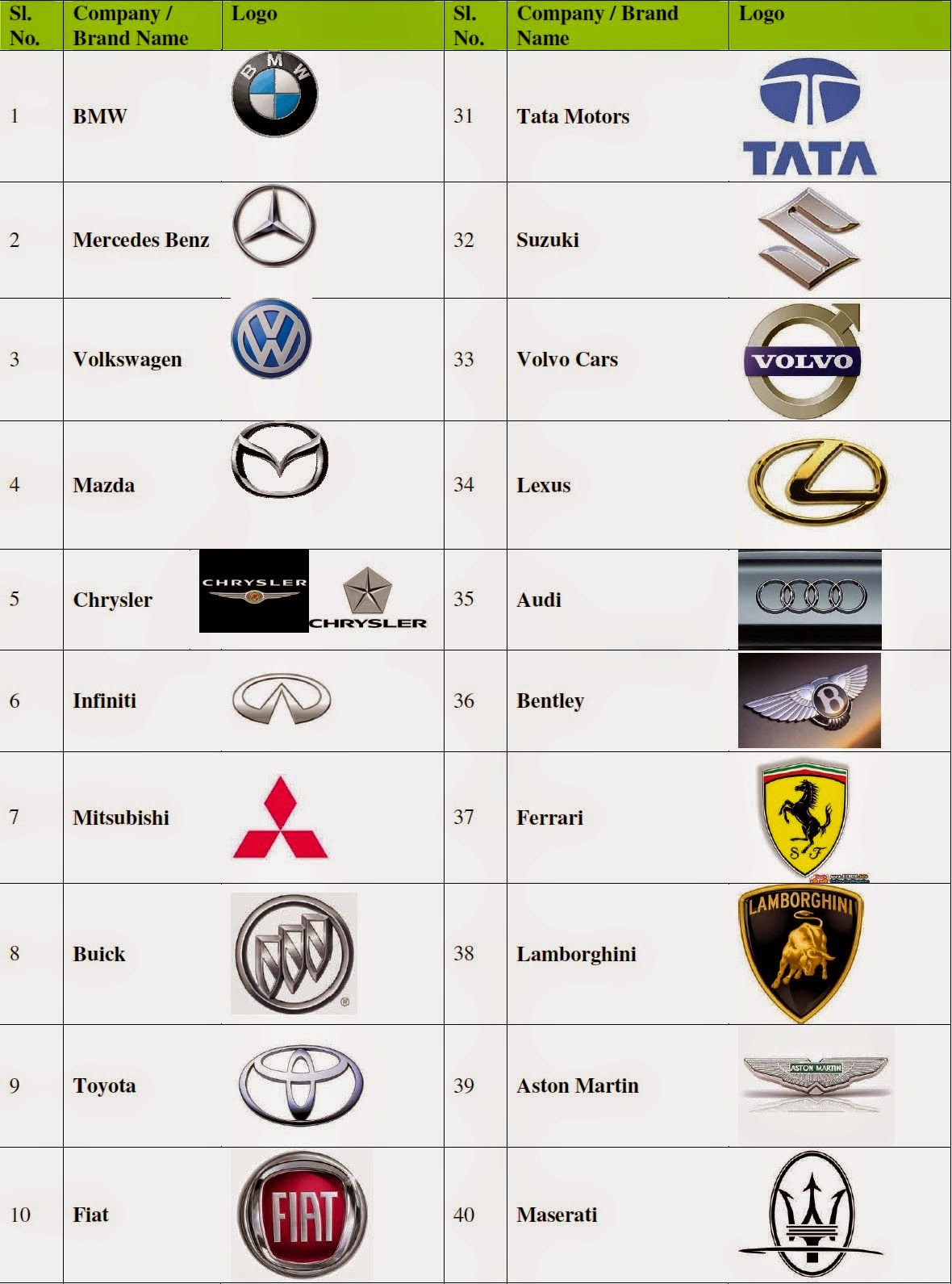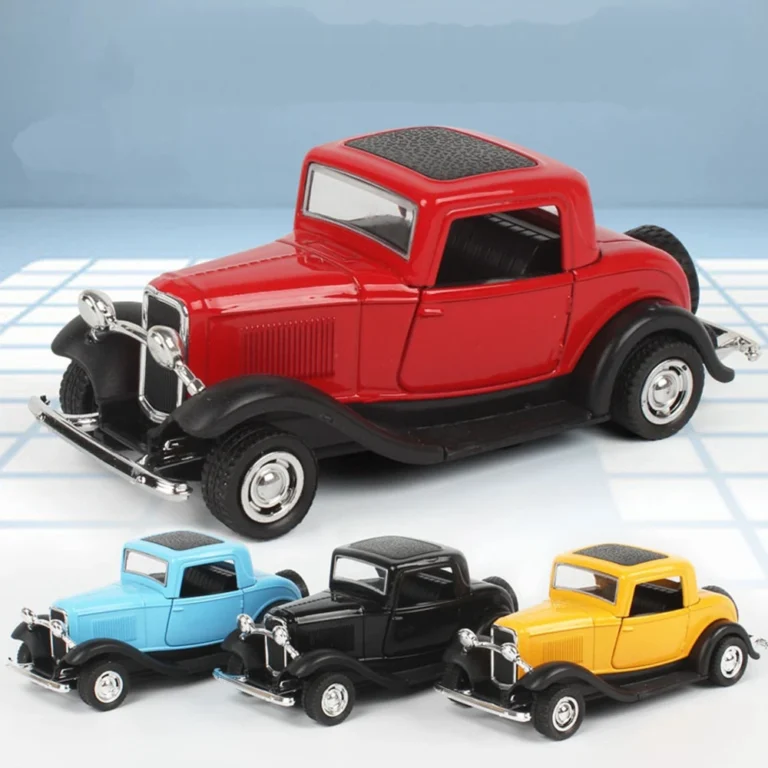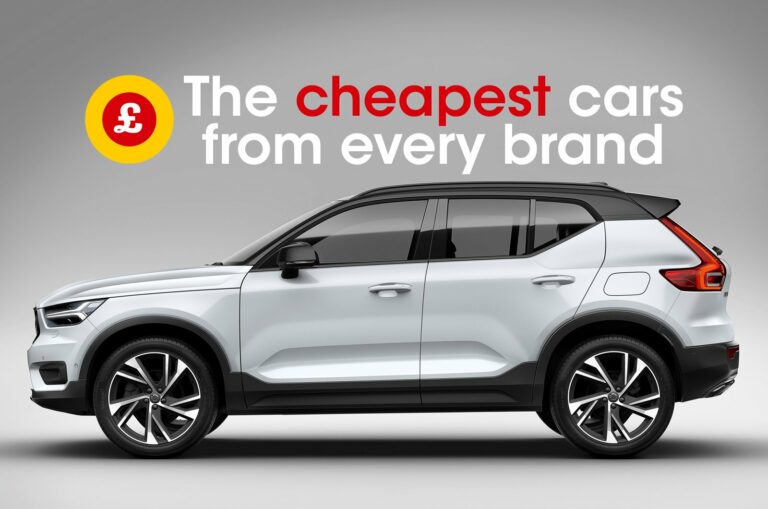All Types Of Car Brands: A Comprehensive Guide to the Automotive Landscape
All Types Of Car Brands: A Comprehensive Guide to the Automotive Landscape cars.truckstrend.com
The world of automobiles is a vast, dynamic, and endlessly fascinating tapestry woven from innovation, engineering prowess, design artistry, and deep-seated cultural identities. At its heart lie the car brands – the names, logos, and reputations that define vehicles and shape our perceptions. Far more than mere badges, car brands represent decades, even centuries, of history, technological advancement, and strategic market positioning. Understanding "All Types Of Car Brands" is not just about memorizing names; it’s about grasping the intricate ecosystem of the global automotive industry, from luxury behemoths to nimble startups, and from mass-market workhorses to bespoke performance machines.
This comprehensive guide will delve into the diverse spectrum of car brands, exploring their origins, market segments, ownership structures, and the exciting trends shaping their future. Whether you’re a prospective car buyer, an industry enthusiast, or simply curious about the names behind the wheels, this article will equip you with a deeper appreciation for the rich variety that defines the automotive world.
All Types Of Car Brands: A Comprehensive Guide to the Automotive Landscape
Categorizing Car Brands by Geographic Origin: The Global Powerhouses
The automotive industry has traditionally been dominated by specific regions, each fostering distinct design philosophies, engineering priorities, and consumer preferences. Understanding these geographic hubs provides a foundational perspective on the types of car brands available globally.
1. European Brands: Engineering Prowess and Design Heritage
Europe is a cradle of automotive innovation, home to some of the oldest and most prestigious car brands.
- German Brands (Precision and Engineering Excellence): Renowned for their meticulous engineering, performance, and luxury.
- Examples: Mercedes-Benz, BMW, Audi, Porsche, Volkswagen, Opel.

- Italian Brands (Passion, Style, and Performance): Synonymous with breathtaking design, high-performance sports cars, and luxury.
- Examples: Ferrari, Lamborghini, Maserati, Alfa Romeo, Fiat.
- British Brands (Luxury, Heritage, and Craftsmanship): Known for their opulent luxury vehicles, iconic sports cars, and rugged off-roaders.
- Examples: Rolls-Royce, Bentley, Aston Martin, McLaren, Jaguar, Land Rover, Mini.
- French Brands (Innovation, Comfort, and Distinctive Design): Often characterized by unique designs, comfortable rides, and a focus on practicality.
.jpg)
- Examples: Renault, Peugeot, Citroën, DS Automobiles.
- Swedish Brands (Safety and Practicality): Pioneers in automotive safety and known for their robust, reliable vehicles.
- Examples: Volvo, Polestar (now an electric performance brand, originally Volvo’s performance arm).

2. Asian Brands: Reliability, Innovation, and Value
Asia has emerged as a dominant force, particularly in terms of volume, reliability, and technological integration.
- Japanese Brands (Reliability, Efficiency, and Innovation): Global leaders in mass production, fuel efficiency, and hybrid technology, often with luxury sub-brands.
- Examples: Toyota, Honda, Nissan, Mazda, Subaru, Suzuki, Mitsubishi, Lexus (Toyota’s luxury division), Acura (Honda’s luxury division), Infiniti (Nissan’s luxury division).
- South Korean Brands (Rapid Growth, Design, and Value): Known for rapid advancements in design, technology, and offering excellent value for money.
- Examples: Hyundai, Kia, Genesis (Hyundai’s luxury division).
- Chinese Brands (Emerging Dominance and EV Focus): Experiencing explosive growth, particularly in electric vehicles, and increasingly expanding globally.
- Examples: Geely (owns Volvo, Polestar, Lotus), BYD, SAIC (owns MG, Maxus), Chery, Great Wall Motor, Nio, XPeng, Li Auto.
3. North American Brands: Power, Size, and American Ingenuity
The US market has historically favored larger vehicles, powerful engines, and pioneering new technologies.
- American Brands (Power, Practicality, and Innovation): Dominated by the "Big Three" and innovative EV startups, known for trucks, SUVs, and bold designs.
- Examples: Ford, Chevrolet, Cadillac, GMC, Buick (all General Motors brands), Chrysler, Dodge, Jeep, Ram (all Stellantis brands), Tesla, Rivian, Lucid Motors.
Categorizing Car Brands by Market Segment and Purpose
Beyond geography, car brands are strategically positioned to cater to specific consumer needs, desires, and budgets. This segmentation helps define a brand’s identity and target audience.
1. Mainstream/Volume Brands
- Focus: Affordability, reliability, practicality, fuel efficiency, and broad appeal. These brands aim for high sales volumes by offering a wide range of vehicles for everyday use.
- Examples: Toyota, Honda, Ford, Volkswagen, Hyundai, Kia, Nissan, Chevrolet.
2. Luxury Brands
- Focus: Premium materials, advanced technology, superior comfort, higher performance, and prestige. These brands often serve as status symbols.
- Examples: Mercedes-Benz, BMW, Audi, Lexus, Genesis, Acura, Cadillac, Volvo.
3. Performance/Sports Car Brands
- Focus: Speed, agility, thrilling driving dynamics, and often distinctive, aerodynamic designs.
- Examples: Porsche, Ferrari, Lamborghini, McLaren, Aston Martin, Corvette (Chevrolet’s high-performance line).
4. Ultra-Luxury/Exotic Brands
- Focus: Exclusivity, bespoke craftsmanship, unparalleled opulence, extreme performance, and often limited production.
- Examples: Rolls-Royce, Bentley, Bugatti, Koenigsegg, Pagani.
5. Off-Road/SUV-Focused Brands
- Focus: Rugged capability, four-wheel drive systems, high ground clearance, and adventurous appeal.
- Examples: Jeep, Land Rover, Subaru (known for AWD on all models), select Toyota models (e.g., 4Runner, Land Cruiser).
6. Electric Vehicle (EV) Specific Brands
- Focus: Pure electric powertrains, cutting-edge battery technology, sustainable manufacturing, and often minimalist or futuristic designs.
- Examples: Tesla, Rivian, Lucid Motors, Polestar, Nio, XPeng, Li Auto. Many traditional brands now have dedicated EV sub-brands or highly emphasized EV lineups.
Understanding Automotive Groups and Conglomerates: The Parent Companies
Many of the car "brands" consumers recognize are actually part of much larger automotive groups or conglomerates. These parent companies own multiple brands, often spanning different market segments and geographic origins. This strategy allows for shared platforms, technology, research and development, and economies of scale.
- Volkswagen Group: A colossal empire owning Volkswagen, Audi, Porsche, Bentley, Lamborghini, Bugatti, Skoda, SEAT, and more.
- Stellantis: Formed from the merger of Fiat Chrysler Automobiles (FCA) and PSA Group, it now encompasses Abarth, Alfa Romeo, Chrysler, Citroën, Dodge, DS Automobiles, Fiat, Jeep, Lancia, Maserati, Opel, Peugeot, Ram, Vauxhall.
- General Motors (GM): Owns Chevrolet, Cadillac, GMC, Buick.
- Toyota Group: Includes Toyota, Lexus, Daihatsu, and Hino (commercial vehicles).
- Hyundai Motor Group: Comprises Hyundai, Kia, and Genesis.
- Renault-Nissan-Mitsubishi Alliance: A strategic partnership sharing technology and platforms across Renault, Nissan, Mitsubishi, Dacia, and Alpine.
- BMW Group: Owns BMW, Mini, and Rolls-Royce.
- Mercedes-Benz Group: Owns Mercedes-Benz, Mercedes-AMG, Mercedes-Maybach, and Smart.
- Geely Holding Group: A rapidly expanding Chinese conglomerate that owns Volvo Cars, Polestar, Lotus, Lynk & Co, Proton, and LEVC (London Electric Vehicle Company).
Understanding these ownership structures is crucial as it explains why vehicles from different brands might share underlying components, engines, or even entire platforms.
Emerging Trends and the Future of Car Brands
The automotive landscape is constantly evolving, driven by technological advancements, environmental concerns, and changing consumer behaviors. Several key trends are reshaping the identity and offerings of car brands:
- Electrification: The most significant trend, pushing all brands towards electric vehicles (EVs). This has led to new EV-only brands emerging and traditional brands electrifying their entire lineups, often creating dedicated EV sub-brands or platforms.
- Autonomous Driving: The development of self-driving technology promises to revolutionize how we interact with cars, potentially shifting the focus from driving pleasure to mobile living spaces. Brands are investing heavily in this area.
- Connectivity and Digitalization: Cars are becoming increasingly connected, offering advanced infotainment systems, over-the-air updates, and seamless integration with smart devices and services. This creates new opportunities for brands to offer subscription services and personalized experiences.
- Sustainability: Beyond powertrains, brands are focusing on sustainable manufacturing processes, recycled materials, and reducing their carbon footprint across the entire supply chain. This is becoming a key differentiator for eco-conscious consumers.
- Mobility Services: Brands are exploring beyond car ownership, venturing into ride-sharing, car-sharing, and subscription models, transforming themselves into broader mobility providers.
- Chinese Global Expansion: Chinese car brands, once primarily domestic, are rapidly expanding their presence in international markets, offering competitive EVs and traditional vehicles.
Practical Advice for Navigating the World of Car Brands
With such a vast array of choices, selecting the right car brand and model can be daunting. Here’s some practical advice:
- Define Your Needs and Budget: Before looking at brands, determine what you need (e.g., family car, commuter, off-roader), your lifestyle, and your realistic budget (including purchase price, insurance, fuel/charging, and maintenance).
- Research Reliability and Safety: Consult independent reviews from organizations like J.D. Power, Consumer Reports, and safety ratings from NHTSA (National Highway Traffic Safety Administration) or IIHS (Insurance Institute for Highway Safety) in the US, or Euro NCAP in Europe. Certain brands consistently rank higher for reliability.
- Consider Resale Value: Brands known for strong resale values (e.g., Toyota, Honda, Subaru, Porsche) can save you money in the long run.
- Test Drive, Test Drive, Test Drive: The only way to truly know if a car is right for you is to drive it. Pay attention to comfort, handling, visibility, and features.
- Look Beyond the Badge: Understand that vehicles from different brands within the same automotive group might share platforms or components. This can mean similar underlying quality or performance, despite different exterior designs and branding.
- Read Owner Reviews: Real-world experiences from current owners can provide invaluable insights into a car’s pros and cons, maintenance costs, and overall satisfaction.
- Evaluate Dealership Experience: The quality of service from a dealership can significantly impact your ownership experience. Research local dealerships for your preferred brands.
Table: Representative Price Tiers for Car Brand Categories (New Vehicle – USD)
It is impossible to list specific prices for "All Types Of Car Brands" as prices vary by model, trim, features, region, and year. However, this table provides representative starting price ranges for new vehicles within different brand categories to illustrate the general market positioning.
| Brand Category | Example Brands | Typical Starting Price Range (New USD) | Key Characteristics & Focus |
|---|---|---|---|
| Mainstream/Volume | Toyota, Honda, Ford, Hyundai, Kia, Nissan, Chevrolet | $20,000 – $45,000 | Affordability, reliability, practicality, fuel efficiency, broad appeal. |
| Luxury | Mercedes-Benz, BMW, Audi, Lexus, Genesis, Acura, Cadillac | $45,000 – $100,000+ | Premium materials, advanced tech, comfort, performance, prestige. |
| Performance/Sports Car | Porsche, Corvette, Alpine, some high-end BMW/Mercedes-Benz | $60,000 – $200,000+ | Speed, agility, driving dynamics, distinctive design. |
| Ultra-Luxury/Exotic | Rolls-Royce, Bentley, Ferrari, Lamborghini, McLaren, Bugatti | $200,000 – $3,000,000+ | Exclusivity, bespoke craftsmanship, extreme opulence/performance. |
| EV-Specific (New Entrants) | Tesla, Rivian, Lucid, Polestar, Nio, XPeng | $40,000 – $150,000+ | Pure electric, cutting-edge battery tech, sustainability. |
| Off-Road/Utility Focused | Jeep, Land Rover, Subaru (AWD focus), certain Toyota/Ford SUVs | $30,000 – $80,000+ | Rugged capability, 4×4, adventure, practicality. |
Note: These are general ranges for base models and do not include top trims, special editions, or optional extras, which can significantly increase the price.
Frequently Asked Questions (FAQ) about All Types Of Car Brands
Q1: How many car brands are there in the world?
A1: It’s nearly impossible to give an exact number as it constantly changes with new startups, mergers, and brands discontinuing. However, there are hundreds of distinct car brands globally, with many being part of larger automotive groups.
Q2: What’s the difference between a car brand and a car manufacturer?
A2: A car manufacturer (e.g., General Motors, Volkswagen Group) is the parent company that produces vehicles. A car brand (e.g., Chevrolet, Audi) is a specific line of vehicles or a division owned by that manufacturer, often with its own distinct identity, marketing, and product line. One manufacturer can own multiple brands.
Q3: Which car brands are generally considered the most reliable?
A3: While reliability can vary by model and year, brands consistently ranking high in reliability studies (like those by J.D. Power, Consumer Reports, and What Car?) often include Toyota, Lexus, Honda, Mazda, Subaru, Kia, and Hyundai.
Q4: Are all electric car brands new companies?
A4: No. While brands like Tesla, Rivian, and Lucid are pure EV startups, many established traditional car brands (e.g., Volkswagen, Mercedes-Benz, BMW, Ford, Hyundai) are heavily investing in and producing electric vehicles, often under their main brand or with dedicated EV sub-brands (e.g., Mercedes-EQ, BMW i, Polestar by Volvo).
Q5: Why do some car brands have luxury sub-brands (e.g., Lexus for Toyota)?
A5: Creating a luxury sub-brand allows a mainstream manufacturer to enter the premium market without diluting its existing brand image. It enables them to offer higher-end features, performance, and customer service to a different demographic while leveraging the parent company’s engineering and manufacturing capabilities.
Q6: What determines a car brand’s reputation?
A6: A brand’s reputation is built on a combination of factors, including its history, reliability, safety record, design aesthetic, driving performance, customer service, innovation, marketing, and public perception over time.
Conclusion: The Ever-Evolving Automotive Tapestry
The world of "All Types Of Car Brands" is a testament to human ingenuity, industrial scale, and diverse consumer desires. From the rugged utility of a Jeep to the unparalleled luxury of a Rolls-Royce, and from the efficient practicality of a Honda to the cutting-edge technology of a Tesla, each brand occupies a unique space in the automotive landscape.
Understanding these distinctions – whether by geographic origin, market segment, or corporate ownership – empowers consumers to make informed choices and appreciate the vast strategic forces at play within the industry. As we look to the future, the automotive world promises even more exciting transformations, with electrification, autonomy, and connectivity poised to redefine what a "car brand" truly represents. The journey of exploration into this fascinating realm is ongoing, promising continuous innovation and new icons to emerge on our roads.






